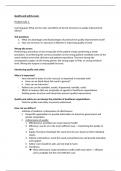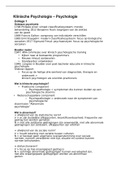Quality and safety exam
Problem talk 1:
Learning goal: What are the roles and effects of formal structures in quality improvement
efforts?
Sub questions:
1. What are advantages and disadvantages of protocols for quality improvement work?
2. How can we know if a structure is effective in improving quality of work
Wrong-site errors:
Performing a procedure on the wrong side of the patient’s body, performing a whole
procedure, or performing the correct procedure on the wrong patient constitute some of the
worst medical errors that clinicians and patients experience. The term wrong-site
encompasses surgery on the wrong person, the wrong organ or limb, or wrong vertebral
level. Wrong-site surgery is unacceptable but rare.
Introducing quality and safety
Why is it important?
- Very relevant in times of crisis- but just as important in everyday work
How can we think about this work in general?
How can we intervene?
- Patient care can be standard, unsafe, fragmented, variable, costly
- Efforts to improve Q&S are marginally on agenda of healthcare organizations
- Existing power structure and hierarchies prevent quality improvement.
Quality and safety are not always the priorities of healthcare organizations.
- Tools for quality and safety are poorly understood.
How can we define it
- Institute of medicine: 6 dimensions of effectiveness
Nonprofit organizations to provide information to American government and
private corporation.
6 dimensions of quality
1. Effectiveness: provided care must improve health
2. Efficiency; you do so in the most sufficient way -> maximizing the quality of
care.
3. Equity: Everyone should get the same level of care, based on their individual
meets.
4. Patient centeredness: meet the needs and preferences and provide education
and support.
5. Safety: Care should be safe, and not lead to harm.
6. Timeliness
These dimensions could sometimes conflict with each other -> efficient
care is probably not the most effective care.
, - 2001: the IoM defined care as living up to its standards and expectations. Good care
is defined in terms of what did we expect from it, both from a biomedical point of
view and from a patient perspective.
- The degree to which service for individuals and populations increased the likelihood
of desired health outcomes and are consistent with our current professional
knowledge.
What one person desires is different from the next person .
- WHO
Shares the same criteria
Same criteria as IoM
- Dutch quality, complaints & disputes act (Wkkgz)
Same criteria as IoM, but replaces equity with transparency.
- Dimensions become part of practices as well
Quality and safety in practice; what is out here
- Many instruments for quality and safety available, think of
Clinical guidelines
Accreditation bodies
Performance indicators
Technologies
Patient participation tools
- However, Q&S are human accomplishments
- We need to take into account the work that people do
Quality and safety in practice; what problems do we encounter
- Explanations that are often given for lacking quality and safety
Instruments are badly implemented
Evidence of how instruments work is lacking
Interactions between instruments and contexts of use are unclear
Interaction between instruments is unclear
What makes it hard to research?
- Practical limitations
Research is often focused on simple interventions in complex environments.
Local insights are rarely universally applicable
There’s still a lot we don’t know
- Different views on what is importance
Healthcare professionals, managers, policy makers tend to focus on instruments,
tools, structures
They often ignore practices of quality and safety
,What characteristics can we discern.
- Q&S are multi-layered
Interactions between macro, meso, micro levels of care.
- Q&S are dynamic
Changes at each level have consequences for quality instruments.
Interactions between instruments, organizations, laws, and protocols
- Q&S are emergent.
Q&S emerge form care practices, they are not inherent properties of care.
Consequences of interventions are unpredictable.
Q&S practice
- What should we do
Reflexive and contextual approach
Less top-down focus on implementing interventions -> could be bottom-up as
well
Move focus on making healthcare resilient.
In short
- Huge and complex challenge
- Dynamic definitions
- Many different instruments
- Effects are poorly understood.
- Multi-layered, dynamic, emergent
Organizing for quality framework
- Six challenges in quality and safety work
Structural: structuring, planning, and coordinating quality efforts
Cultural: giving quality a shared, collective meaning, value and significance within
the organization.
Educational: creating and nurturing a learning process to support continual
improvement.
Political: Addressing the politics and negotiating the buy-in, conflict and
relationships of change.
Technological & physical: designing physical infrastructure, and technological
systems supporting the quality efforts.
Emotional: Inspiring, energizing, and mobilizing people by linking QI to inner
sentiments and deeper commitments. -> about inspiring and motive people; how
do you get people on board.
->They form a basis of a conceptual framework that we use in this course
Framework
- Tells u not how quality and safety should be done -> we use it as a new way of looking
at quality and safety -> analytical framework.
- The six challenges lie at the core of the book -> based on qualitative research
conducted in several hospitals that made successful quality improvements.
- They identified 6 challenges that all healthcare organizations face to improve quality
and safety of health care delivery.
, Outer context: macro context in which quality and safety should take place ->
regulations, markets.
Outer context: market & resource environment, technological
environment, political and regulatory environments, social and cultural
environments.
Inner context: meso level of organization -> In terms of structure.
Organization size, organization structure, organization performance.
Six challenges (Hans Vermaak) -> learning to change.
The challenges are focused on work you need to do in quality improvement -> things to think
about to improve the quality and safety of healthcare.
- Structural challenges: challenge around structuring, planning, and coordinating
quality efforts. What kind of structures are present -> how can we change these
structures (Bate et al)
Good structures are essential for organizing quality effort (strategies, information
sharing, coordination, dedicated teams).
Too much focus on structure can be a bad thing -> can lead to fragmentation, and
decoupling.
We need good structures in organizations -> on meso and macro level.
Not always that more structures lead to better quality and safety -> where do
they get these ideas from: they conducted research -> how they did their quality
work -> the framework we use is based on ethnography research: what do they
do.
Inspector about guidelines, rules, and structures: did you adhere to the protocol -
> if there was a protocol -> improvement: better adherer to the protocol.
You need to understand why the nurse did not follow the protocol ->
follow what they should have done.
What you need to research when someone doesn’t follow the protocol:
why didn’t he follow the protocol. For example, cultural. Or you think the
protocol is not right for this situation -> you should discuss this with
colleagues and patients to know this is the right choice.
Which protocols are useful and which situation -> in this choice, many
aspects should have been weighted.
Decoupling: you have protocols -> but you look one week before the
evaluation to the protocols to determine whether you adhere to the
protocols-> you don’t actually follow it during the whole period.
We are going to look to the practices that people do when focusing on quality and
safety.
- Cultural challenge; giving quality a shared, collective meaning, value and significance
(within organization).
Culture is crucial for sustaining change and for process of sensemaking -> culture
of reflexivity, culture of innovation, culture of openness and sharing.
However, there are also dysfunctional cultures (think of clan culture, a toxic
culture on the work floor).
What is culture of your organization -> how can you change it, it is crucial for
sustaining.







